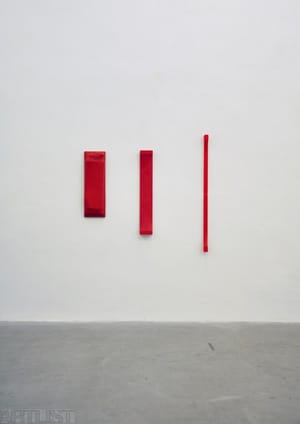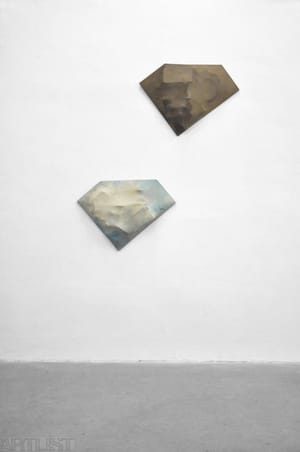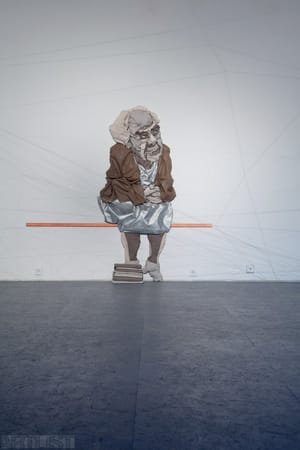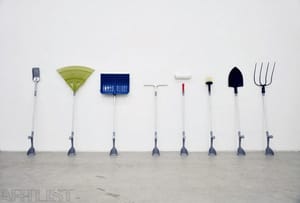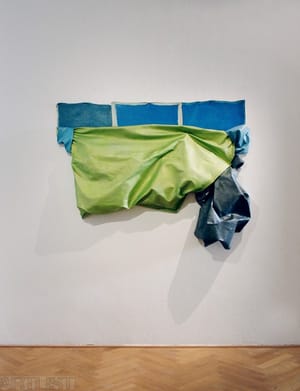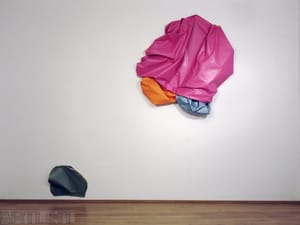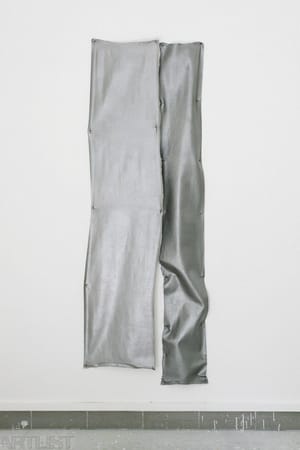- First Name
- Petr
- Surname
- Dub
- Born
- 1976
- Birth place
- Brandýs nad Labem
- Place of work
- Prague, Brno and Reykjavik
- Website
- www.petrdub.cz
- Keywords
- CSU Library
- ↳ Find in the catalogue
About artist
When observing the work of Petr Dub I am often curious about what is inside, what it is made of, how it holds together, what will happen to it when the exhibition is over, how it belongs, whether it is always the same, etc. That means I am interested (as probably other viewers are) in the specific materiality of the given piece of work, which often has the character of a process. It is about certain matter, which, however, represents a special case of artistic matter – leftovers from the studio and various relics or new fabrics that primarily serve the purpose of origin of a new piece of art work (canvases, frames, colours and painting tools, although not only artistic, but also craft – paint rollers, etc.) It is not material designated for other purposes like for construction or to produce a car. Therefore it is material somehow functional, predestined, not indifferent matter designated for forming and making it specific. The initial material, is already specified in some way, even before organizing it, even before the compositional act. It is rather about the forming of a function, while there is no principal difference between the primary function and the final form, but there is sequence. In the beginning there can be, for example, a canvas and colours – i.e. materials that are functionally defined as artistic matter and in this sense they are worked with in an almost sculpting sense of the word, they are rather plastically formed, moulded with touch and not illusionistically treated inside an area in the direction of being virtual. Canvas is painted, coloured, a coloured layer is applied to it, a picture is not painted on it, a picture is not inside the canvas, but the entire canvas is just becoming a part of the painting. What used to be traditionally a whole, is becoming a part, the initial functionally identical matter is not always used in a traditional way. The canvas and frame do not define the painting, although they identify it, nevertheless the painting is something broader. It is not even about these traditional materials being only a part of an installation – in that case they would be removable; an installation is a sort of correlation of sense, configuration of a signal in its identity interchangeable for another fully testifying element, they are allegories. That is not the case of Petr Duba’s configurations. Of course, even here the elements are movable, nevertheless the goal is not an allegoric message, but a visual impression, visible, possibly tangible, surface and relief. The fundamental element here is the sensual quality of materials, pleasure in viewing, possible touching. With his look the viewer caresses the surface and corrugation of materials formed into shapes. The proportions of the shapes and logics of arrangement are also important, however. Therefore pleasure (conceptual) is also present. Mostly, however, we do not need to necessarily know the literary point; the overall perception of the logical order (Gestalt) is enough. That gets us to the psychology of the view. An enclosed Gestalt is a model of itself, a model of living world. The traditional notion of the form roughly amounts to this meaning. Form is here, however, as I have already mentioned, by forming functional matter, by forming an expectation. This expectation has spatial character since its horizon is a thing. An idol serves for caressing, it’s not substitutional, it does not update the present. An idol is present, it is here. It takes place in time, it is occurring. I understand the work of Petr Dub as occurring shapes.
- Author of the annotation
- Václav Hájek
- Published
- 2011
CV
Studies:
2009-2012 Faculty of Fine Arts, Brno, doctoral program (intermedia studio of Václav Stratil)
2003-2009 Faculty of Fine Arts, Brno (painting studio 1-3, Petr Veselý, Martin Mainer, Petr Kvíčala)
2005 Academy of Arts, Architecture and Design in Prague (studio of conceptual and intermedial work, Jiří David, Milan Salák)
2000-2003 Private University of Fine Arts in Zlín (studio of applied arts, René Hábl, Pavel Preisner)
1998-1999 Academy of Artetherapy in Tábor
Awards:
2011 Essl Award finalist, (Prague City Gallery, CZ)
2010 The Sovereign European Art Prize finalist (London, UK)
2009 Rector’s Prize (BUT Brno),
Exit finalist (national fine arts student competition, UJEP, Ústí nad Labem, CZ), nominated for the Start Point Prize (selection of European fine art graduate works, Gallery Klatovy/Klenová, CZ),
Dean’s Prize (diploma work Unframed, FaVU, Brno)
2008
2nd place, International Bienal of Contemporary Arts, photo section (Chapingo, Mexico)
2006 Rector’s Prize (BUT, Brno, CZ)
2005 Studio Prize (AM3, FaVU VUT, Brno)
Exhibitions
- Solo exhibitions
-
Selection:
2013
Fore! Kaluz Gallery, Ostrava
Rehabilitation in the context of out-of-court settlements of consumer disputes, Kvalitar Gallery, Prague
2012
pole position, Spz Gallery, Prague
In medio stat virtus, Deniska Gallery, Olomouc
It is practically associated with the bush you have been beating about, Ars Gallery, Brno
apo, ibu, neuro and idiots, Era, Brno
Shallow, Umakart, Brno
2011
Ohlasy entropie (Galerie Kritiků, s Matějem Al-Ali a tomášem Moravcem, Praha, ČR)
Kustodka – Start Up (Galerie hlavního města Prahy, Dům U Zlatého prstenu, Praha, ČR)
Chemnitz.cz – práce věnované konci světového pořádku (Galerie Weltecho, Chemnitz, DE)
Superend a jiné ošklivé příběhy (Café Cosmos, Mnichov, DE)
2010
Velké ambice (Galerie Půda, Jihlava, ČR)
Simulovaná show (Galerie 1k15, Brno, ČR)
2009
Oddělení malby (Galerie trojka, Brno, ČR)
2008
Reframed – House of Dublon (Galerie mladých, s Janou Bernartovou (Brno, ČR)
Obrazárna (Galerie Milana Zezuly, Brno, ČR)
2007
Léčba neklidem (Galerie Fiducia, Ostrava, ČR)
2006
“Banka” (HVB Bank, pobočka Valdek, s Petrem Kunčíkem, Praha, ČR)
2004
Definitivní řešení opičí otázky (Galerie mladých, Brno, ČR)
2003
7 let ve Zlíně (Galerie Rock Café, Praha, ČR)
Versus (s Petrem Kunčíkem, Galerie Mokrá, Zlín, ČR)
- Group exhibitions not included in ARTLIST.
-
2013
Poison green, Czech centre gallery, New York, New York
Od moderny po současnost, Muzeum města Brna, Brno
Red8, Galerie vysoké školy umělecko průmyslové v Praze, Praha
2012
Paf – Sekce animace urbanismu, Umělecké centrum Univerzity Palackého, Olomouc
4+4 dny v pohybu/17. ročník mezinárodního festivalu současného umění, Casíno Pařížská, Praha
Geometrův zlý sen, Topičův salon, Praha
Preview, Fait gallery, Brno
Pokoj šíleného sběratele, Artbanka museum of young art, Praha
You can tell me! Factory-art gallery, Berlin
Práce ze sbírky Charlie Younga, Oswego library art gallery, New York, New York, USA
Kvalitář, Kvalitář, Praha
2011
Konečně spolu (Galerie Emila Filly, Ústí nad Labem, ČR)
Artbanka (Galerie hlavního města Prahy, Dům U Zlatého prstenu, Praha, ČR)
Pražské Quadriennale (PQ+, Praha, ČR)
Amoya (Artbanka Museum Of Young Art, Praha, ČR)
Essl Art Award 2011 (Galerie hlavního města Prahy, Praha, ČR)
Kick Off Artbanka (Dvorac Sec Contemporary, Praha, ČR)
2010
Exit/a.a.0. (Kunstraum Kreuzberg/Bethainem, Berlín, DE)
The Sovereign European Art Prize (Barbican Centre, Londýn, VB)
Genesis (The Rag Factory, Londýn, UK)
Chytré a hloupé (Galerie Kritiků, Praha, ČR)
2009
Exit 2009, finále národní soutěže studentů uměleckých škol (galerie Emila Filly, Ústí nad Labem, ČR)
Zlínský pohled světa (Krajská galerie ve Zlíně, ČR)
Urban Kiss (Galerie Kritiků, Praha, ČR)
Start Point, selekce nejlepších diplomových prací 2009 (Galerie Klatovy/Klenová, ČR)
Mag 09 (Galerie Brno, ČR)
2008
Bienal Of Contemporary Art Champigno (Texcoco, MX)
CZ/SK (Wannieck Gallery, Brno, ČR)
V Praze je blaze (Galerie Kritiků, Praha, ČR)
Petr Kvíčala + studenti (Reduta, Brno, ČR)
2007
Ruční pila (Galerie Sýpka, Valašské Meziříčí, ČR)
Vzpomínka, za kterou se stydím (Galerie AVU, Praha, ČR)
Amaro Jilo (Dům umění, Brno, ČR)
Zlínský salon mladých (Krajská galerie ve Zlíně, Brno, ČR)
2006
Arskontakt 2006 (Galerie Arskontakt, Brno, Galerie AVU, Praha, ČR)
Am3 (Galerie Gaudeamus, Ostrava, ČR)
2005
Artkontakt 2006 (Galerie Arskontakt, Brno, Galerie AVU, Praha, ČR)
Podoby současné tvorby (Galerie “10″, Brno, ČR)
2004
MMS – Martin Mainer Studio (Reduta, Brno, ČR)
Audio Video Cirkus Vol. 2 (Klub Dessert, Brno, ČR)
- Collections
-
amoya
dvorak sec contemporary
fait gallery
jhk archiv
kvalitář
galerie ad astra
galerie ars
galerie arskontakt
galerie němeček
muzeum města brna
sbírka marek
sbírka jiřího valocha
sbírka thorira gunnarsona
Monography
- Monography
Vybrané postkonceptuální přístupy v současné české malbě (Petr Dub, Edice Ph.D. FaVU, 2013)
- Personal texts not included in database
Aluzivní malba-objekt
(text komentované prohlídky výstavy Ohlasy entropie, Vlasta Čiháková Noshiro, 24. 7. 2011)
Unframed & Reframed (Tomáš Pospiszyl, 2010)
Reframed (Časopis Ateliér, č. 3, Jiří Valoch, 2009)
Reframed – House OF Dublon (TZ, Jan Zálešák, 2008)
Zlínský salón mladých (Václav Mílek, 2006)

